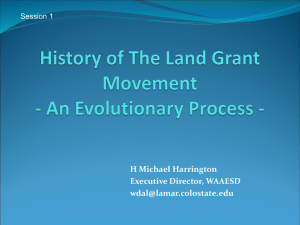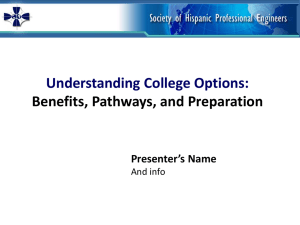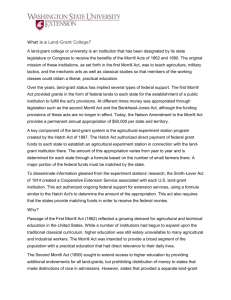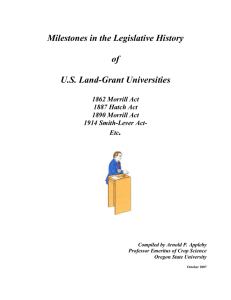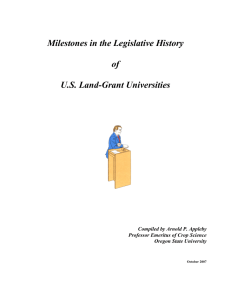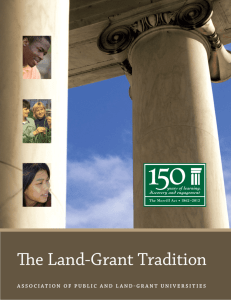The Land Grant Movement - An Evolutionary Process -
advertisement
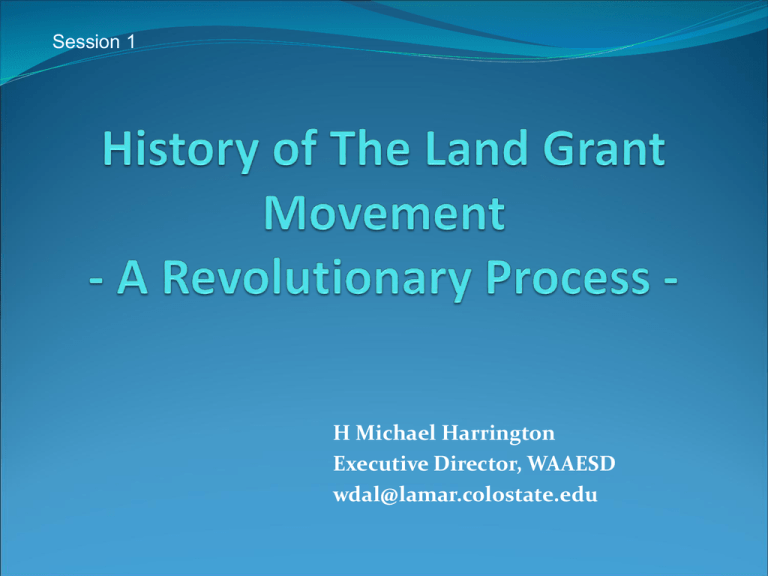
Session 1 H Michael Harrington Executive Director, WAAESD wdal@lamar.colostate.edu Outline History Challenges for the 21st Century Relevant or Relic? Myth vs. Reality? Our Comparative Advantage Back to the Futture The US in the 1800s 85% of the population resided on farms or small towns Higher education was dominated by Private Universities with emphasis on Law, Medicine, Philosophy and Literature • Available only to the “landed gentry” • Generally elitist • Education was a “state’s right” issue, not a federal matter Historical Background • How did it all get started? • 1830’s – Jonathan Baldwin Turner • “Plan for a State University for the Industrial Classes” • Justin Morrill’s first attempt at establishing support for public education was passed by Congress but vetoed by President Buchanan in 1859 • The “land grant bill” was reintroduced in 1861 and signed into law in 1862 – The Morrill Act • Why was this legislation passed in 1862, while being vetoed earlier? The Morrill Act of 1862 • A bold new experiment – a profound innovation • Created in the belief that American social and economic development was best served if higher education was made broadly available to all • The first social contract between this nation and its citizens, creating the “Peoples Colleges” • July 1862 • Lincoln establishes USDA • Signs the Homestead Act • Signs the Morrill Act The Morrill Act of 1862 • Established a public, federally assisted system of higher education • Congress chose not to use federal funds, but rather LAND (via the Homestead Act), to encourage states to participate • Congress was cash short The Morrill Act - 1862 • An act donating public lands .. Which may provide colleges for the benefit of agriculture and the mechanical arts • “to establish one college where the leading object shall be without exclusion of other scientific and classical studies, and including military tactics, to teach such branches of learning as related to agriculture and the mechanical arts, in order to promote the liberal and practical education of the industrial classes in the pursuits and professions of life..” Hatch Act of 1887 Created a research and experimentation effort focused in the public interest Divested and shared the research and discovery efforts with the states and their newly formed colleges Established the role of government in stimulating local or regional economic growth and development Second Morrill Act of 1890 • The second Morrill Act provided for the creation and funding of the 17 historically black land grant institutions and Tuskegee Institute Smith Lever Act of 1914 Created out of a need to disseminate information for the public good Information was not reaching farmers Congress created a new funding mechanism that established a three-way partnership Territories included in LGU System Territorial Colleges and Universities become LGUs in 1971 Puerto Rico Virgin Islands Guam, Micronesia American Samoa Northern Marianas Recognition of the 1994’s The Equity in Educational Land Grant Status Act of 1994 conferred LGU status on the Native American colleges as a provision of and authorized the creation of an endowment to support the 1994 institutions. Important Dates 1862 - Morrill Act provides land for college of agriculture and mechanical arts 1887 - Hatch Act creates Agricultural Experiment Stations - 15 States have formally organized Agricultural Experiment Stations - The Association of American Agricultural Colleges and Experiment Stations formed 1890 - Second Morrill Act broadens land-grant program and sets up funding for traditionally black–serving universities 1893 - 49 experiment stations exist under the Hatch Act 1889 - Department of Agriculture raised to Cabinet status 1914 – Smith Lever legislation created the Extension Service 1946 – The Research and Marketing Act of 1946 required the use 25% of Hatch funds for regional or multistate research 1971 – Territorial Colleges and Universities become LGUs 1994 – Tribal Colleges become LGUs 1994 – CSREES is created by combining CSRS and CES 1998 – AREERA requires annual POW and reports, multistate extension and integrated research and extension activities 2009 – Creation of the National Institute of Food and Agriculture Land Grant Colleges and Universities National Associations 1887 - Association of American Agricultural Colleges and Experiment Stations (AAACES), 1919 - AAACES became the Association of Land-Grant Colleges (ALGC) 1926 - ALGC became the Association of Land-Grant Colleges and Universities (ALGCU) 1963 - Merged with National Association of State Universities (NASU) and the State Universities Association (SUA) to form the National Association of State Universities and Land-Grant Colleges (NASULGC) 2009 – NASULGC becomes Association of Public and Land Grant Universities (APLU) The Central Theme of the Land Grant Colleges and Universities LGU’s have always broken with tradition and pursued the non-traditional Accessibility, research and discovery in the public interest, and engagement with stakeholders is our hallmark “It’s what makes us different!” Recent Trends Presidents and Provosts concerned about rankings Decreased or changing funding sources Reduced state and county funding Increasing tuition Increasing reliance on contracts and grants Emphasis on entrepreneurial activities Differential cuts to Ag Colleges Recent Trends, cont. Changing stakeholder needs Declining agricultural population Larger production units Increasing demand for safer, more healthful food Emergence of niche markets Changing demographics Fundamental disconnect between agriculture and food in stores Less that 2% of population are involved in food production But Everyone Eats!! Challenges of the 21st Century • Can LGUs remain a critical component of the public educational landscape? • Can we recognize the challenges? – Funding – Mission creep – Inaccessibility – Accountability • Develop flexibility to respond rapidly to timely issues Is The Land Grant Mission Obsolete? Are we meeting 21st Century needs? Have we become too Elitist? Does the public still place value on it’s investments in public higher education? Are we really a System! Do we make unified decisions? Do our Chancellors and Presidents really work together for the common good? Are we focused too much on rankings? Public Good versus Private Benefits This is the heart of the issue Do our publicly elected officials understand PG vs. PB? Do we make decisions within our universities on the basis of the Public Good that will result? Are our contributions still viewed as impacting the public good? Embracing the Future What is our comparative advantage? Are we using it? With our network and outreach capacity, we have an unfair advantage, but can we use it effectively? How do we use it for determining priorities? Rediscovering our Comparative Advantage • What can we do best in light of 21st Century realities? • How do we create partnerships and collaborative arrangements to maximize efficiency? • Can we persuade the general public that investments in higher education will result in payoffs that are worth accruing? • How do we demonstrate benefit to society? Are We Relevant? Of course we are! Are we a Myth or a Reality? Have we lost our way? - Yes, to a degree. Can we adapt? – Yes, we must! Questions for Moving Forward Are we addressing important stakeholder identified needs? Are we successful in developing programs for new and/or nontraditional audiences? Are we accountable to our stakeholders? Can we document attitudinal, knowledge or behavioral change in targeted audiences? Questions for Moving Forward • Are we building effective teams with collaborators on and off campus? • Are we targeting niches where we can make unique contributions to problem solving? • Are we achieving outcomes that are well-defined and specific to priority audiences? • And most importantly…, Are we communicating the above effectively? Back to the Future • Return to the original focus/intent of the Land Grant • • • • university Implement a strategic plan to recruit, retain and prepare students for tomorrow Broaden the student experience Broaden the role of food and agriculture in the overall university curriculum Prepare faculty to teach effectively and reward success A Roadmap for The Future • Implement programs in K-12 to increase the awareness of • • • • • agriculture role in addressing societal issues Implement “in service” workshops for K-12 teachers Build stronger connections among LG Institutions and strive to make the partnership really work Build strategic partnerships to benefit students, internships, meaningful international partnerships, cooperative education programs Improve and reward meaningful mentoring Initiate serious reviews of undergraduate programs Some Initial Steps • Market the LGU Mission as a unique asset • We must begin to think of ourselves as one and not three different • • • • • entities (instruction, extension and research) Highlight the integration of teaching, research and extension Demonstrate the impacts and value of the mission-driven work and organization Focus today’s major challenges – Energy and Food Security, Human Health, and Global Climate Change within the local context Highlight the use of our political networks, access to stakeholders, and distribution networks to support the Land Grant initiative (and University) instead of competing against ourselves Reinvest in the Land Grant University System at the federal level “Education is simply the soul of a society as it passes from one generation to another.” - As G. K. Chesterton Calculation of Formula Funds Hatch Not less than 52% allotted to each state, half based on % of total rural population, half based on the % of total number of farms* Not less that 25% (of total) for multistate research 3% to the Secretary of Agriculture for administration Evans Allen 3% to the Secretary of Agriculture for administration 20% in equal proportions 40% allotted based on % or total rural population+ Remainder allotted based on % % of total number of farms* (*as determined by the most recent census) Calculation of Formula Funds Smith Lever 4% to the Secretary of Agriculture for administration 20% in equal proportions 40% allotted based on % of total rural population* Balance based on % of total number of farms* 1890 Extension 4% to the Secretary of Agriculture for administration 20% allotted to each institution 40% allotted based on % of total rural population* Balance based on % of total number of farms* (*as determined by the most recent census) Selected References The Morrill Land Grant Act of 1862 and The Changing of Higher Education in America; available from Tom Fretz <tfretz@umd.edu> The Land Grant Tradition, NASULGC (See APLU Library) Induced Innovation: The Story of the Land-Grant Universities; Michael V. Martin Justin Smith Morrill Lecture, 2007 NASULGC (APLU) Annual Meeting Where Are Land-Grant Colleges Headed? ; Henry Fribourg, J. Nat. Resour. Life Sci. Educ.,Vol. 34, 2005 Exploring A New Role For Federal Government In Higher Education; Mark G. Yudof, President UC System
